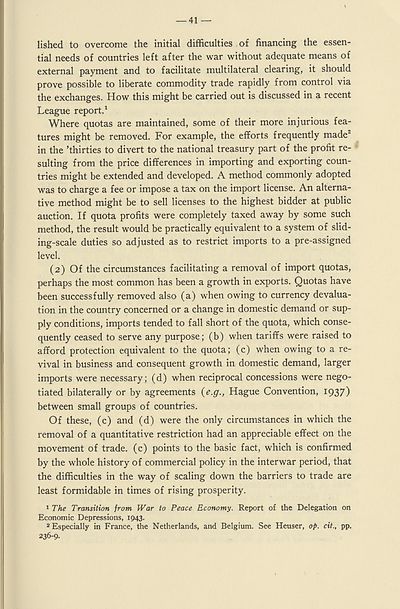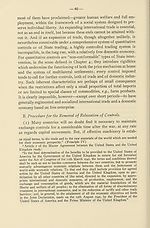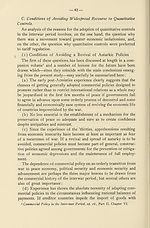Download files
Complete book:
Individual page:
Thumbnail gallery: Grid view | List view

41 —
lished to overcome the initial difficulties of financing the essen¬
tial needs of countries left after the war without adequate means of
external payment and to facilitate multilateral clearing, it should
prove possible to liberate commodity trade rapidly from control via
the exchanges. How this might be carried out is discussed in a recent
League report.1
Where quotas are maintained, some of their more injurious fea¬
tures might be removed. For example, the efforts frequently made2
in the ’thirties to divert to the national treasury part of the profit re¬
sulting from the price differences in importing and exporting coun¬
tries might be extended and developed. A method commonly adopted
was to charge a fee or impose a tax on the import license. An alterna¬
tive method might be to sell licenses to the highest bidder at public
auction. If quota profits were completely taxed away by some such
method, the result would be practically equivalent to a system of slid¬
ing-scale duties so adjusted as to restrict imports to a pre-assigned
level.
(2) Of the circumstances facilitating a removal of import quotas,
perhaps the most common has been a growth in exports. Quotas have
been successfully removed also (a) when owing to currency devalua¬
tion in the country concerned or a change in domestic demand or sup¬
ply conditions, imports tended to fall short of the quota, which conse¬
quently ceased to serve any purpose; (b) when tariffs were raised to
afford protection equivalent to the quota; (c) when owing to a re¬
vival in business and consequent growth in domestic demand, larger
imports were necessary; (d) when reciprocal concessions were nego¬
tiated bilaterally or by agreements (e.g., Hague Convention, 1937)
between small groups of countries.
Of these, (c) and (d) were the only circumstances in which the
removal of a quantitative restriction had an appreciable effect on the
movement of trade, (c) points to the basic fact, which is confirmed
by the whole history of commercial policy in the interwar period, that
the difficulties in the way of scaling down the barriers to trade are
least formidable in times of rising prosperity.
1 The Transition from War to Peace Economy. Report of the Delegation on
Economic Depressions, 1943.
2 Especially in France, the Netherlands, and Belgium. See Heuser, op. cit., pp.
236-9.
lished to overcome the initial difficulties of financing the essen¬
tial needs of countries left after the war without adequate means of
external payment and to facilitate multilateral clearing, it should
prove possible to liberate commodity trade rapidly from control via
the exchanges. How this might be carried out is discussed in a recent
League report.1
Where quotas are maintained, some of their more injurious fea¬
tures might be removed. For example, the efforts frequently made2
in the ’thirties to divert to the national treasury part of the profit re¬
sulting from the price differences in importing and exporting coun¬
tries might be extended and developed. A method commonly adopted
was to charge a fee or impose a tax on the import license. An alterna¬
tive method might be to sell licenses to the highest bidder at public
auction. If quota profits were completely taxed away by some such
method, the result would be practically equivalent to a system of slid¬
ing-scale duties so adjusted as to restrict imports to a pre-assigned
level.
(2) Of the circumstances facilitating a removal of import quotas,
perhaps the most common has been a growth in exports. Quotas have
been successfully removed also (a) when owing to currency devalua¬
tion in the country concerned or a change in domestic demand or sup¬
ply conditions, imports tended to fall short of the quota, which conse¬
quently ceased to serve any purpose; (b) when tariffs were raised to
afford protection equivalent to the quota; (c) when owing to a re¬
vival in business and consequent growth in domestic demand, larger
imports were necessary; (d) when reciprocal concessions were nego¬
tiated bilaterally or by agreements (e.g., Hague Convention, 1937)
between small groups of countries.
Of these, (c) and (d) were the only circumstances in which the
removal of a quantitative restriction had an appreciable effect on the
movement of trade, (c) points to the basic fact, which is confirmed
by the whole history of commercial policy in the interwar period, that
the difficulties in the way of scaling down the barriers to trade are
least formidable in times of rising prosperity.
1 The Transition from War to Peace Economy. Report of the Delegation on
Economic Depressions, 1943.
2 Especially in France, the Netherlands, and Belgium. See Heuser, op. cit., pp.
236-9.
Set display mode to:
![]() Universal Viewer |
Universal Viewer | ![]() Mirador |
Large image | Transcription
Mirador |
Large image | Transcription
Images and transcriptions on this page, including medium image downloads, may be used under the Creative Commons Attribution 4.0 International Licence unless otherwise stated. ![]()
| League of Nations > Economic and financial section > Quantitative trade controls > (43) |
|---|
| Permanent URL | https://digital.nls.uk/190588552 |
|---|
| Shelfmark | LN.II |
|---|
| Description | Over 1,200 documents from the non-political organs of the League of Nations that dealt with health, disarmament, economic and financial matters for the duration of the League (1919-1945). Also online are statistical bulletins, essential facts, and an overview of the League by the first Secretary General, Sir Eric Drummond. These items are part of the Official Publications collection at the National Library of Scotland. |
|---|---|
| Additional NLS resources: |
|

